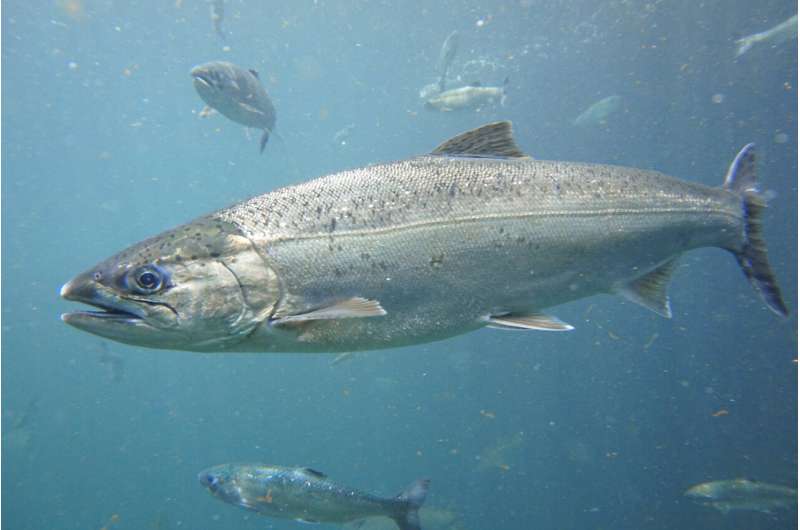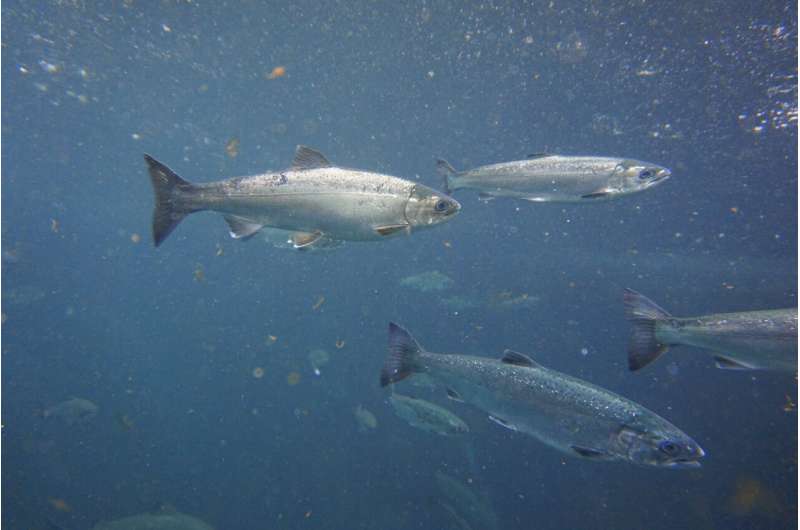'Safety in numbers' tactic keeps Pacific salmon safe from predators

Animals that live in groups tend to be more protected from predators. That idea might be common sense, but it's difficult to test for some species, especially for wild populations of fish that live in the ocean.
A new University of Washington study that leverages historical data has found unique support for the "safety in numbers" hypothesis by showing that Pacific salmon in larger groups have lower risk of being eaten by predators. But for some salmon species, schooling comes at the cost of competition for food, and those fish may trade safety for a meal. The study was published June 29 in the journal Science Advances.
"With salmon, most people think of them spawning in freshwater streams, but there's also this huge amount of time they spend in the ocean feeding and growing," said lead author Anne Polyakov, a doctoral student in the UW's interdisciplinary Quantitative Ecology and Resource Management Program and the School of Aquatic and Fishery Sciences. "One of the reasons why this study is so unique is that we essentially can't observe these fish at all in their natural ocean environment, and yet we're able to pull out these really strong results on how grouping affects predation risk and foraging success for individual fish using this incredibly valuable dataset."
The researchers looked at four species of Pacific salmon—sockeye, chum, coho and pink—drawing on an international fisheries dataset collected for these species from 1956 to 1991. While their individual life histories vary by species, all salmon are born in freshwater streams, then migrate to the ocean to feed and grow before returning to their home streams to lay eggs, spawn and die, continuing the lifecycle for the next generation.
This study relied on analyzing existing historical data in new ways. For more than four decades the UW's Fisheries Research Institute in partnership with the International North Pacific Fisheries Commission recorded salmon catch data across the North Pacific Ocean as part of managing each species. The study's authors analyzed catch data from purse seine nets—fishing gear that involves dropping a net and capturing all of the fish in a relatively small volume of water. By looking at numbers of fish caught in one of these nets, the researchers could estimate the size of the schools in which each fish had been swimming.
Additionally, the historical data included careful records of predator wounds on the salmon, plus the stomach contents for a subset of the fish caught. In this way, the researchers could estimate both predator encounters and feeding success for salmon across 45 years, spanning the entirety of the North Pacific Ocean—making this a unique and valuable data set.

"It was serendipitous that these data were available. They suggest that salmon are social during the ocean stage of their life and reveal the benefits and costs of this sociality," said senior author Andrew Berdahl, an assistant professor in the UW School of Aquatic and Fishery Sciences. "Grouping is very common in marine fish and we think this is largely to help them evade predators, yet there's actually not much empirical support showing this, especially from wild populations. I think this study is a piece of the foundation that many didn't realize was missing."
By looking at the number of fish caught in purse seine nets as a proxy for group size, the researchers then estimated predator risk by considering the fraction of fish in each set that had predator wounds. Fish in larger groups were much less likely to be wounded, across species. For example, with sockeye salmon, an increase in 100 fish in a group cut predation risk in half. Also, wound data showed that fish whose bodies were larger or smaller than others in their group were more likely to be attacked by a predator. This suggests that the salmon's safety in numbers comes from confusing their predators because visually distinct—larger or smaller—individuals were easier for predators to keep track of.
The researchers also found that for two salmon species—sockeye and chum—fish in larger groups had less food in their stomachs. These fish sometimes sacrificed a meal to remain protected in a group and avoid predators. The team didn't notice this pattern for pink and coho salmon, however. One possible reason for this, the researchers said, is that sockeye and chum salmon spend a much longer portion of their lives in the ocean, and also tend to travel farther away from their home streams than other species. Spending more time and traveling farther out in the ocean generally means food is harder to find, leading to more competition and less food for fish in larger groups.
The authors hope this paper inspires eventual consideration of group size distributions and the benefits and costs of grouping in current fisheries management models—as well as dusting off other data sets to reveal relevant findings.
"Many of these data sets came at great cost and I think there's a lot in them still ready to be uncovered," Berdahl said. "I would hope it also motivates people to think about the ecological implications of collective behavior—in this case, how grouping impacts the food web, both by changing the rate a species is being eaten as well as the rate at which it is consuming others."
Other co-authors are Tom Quinn, a UW professor of aquatic and fishery sciences, and Katherine Myers, previously a research scientist at the UW School of Aquatic and Fishery Sciences.
More information: Anne Y. Polyakov et al, Group size affects predation risk and foraging success in Pacific salmon at sea, Science Advances (2022). DOI: 10.1126/sciadv.abm7548. www.science.org/doi/10.1126/sciadv.abm7548
Journal information: Science Advances
Provided by University of Washington



















